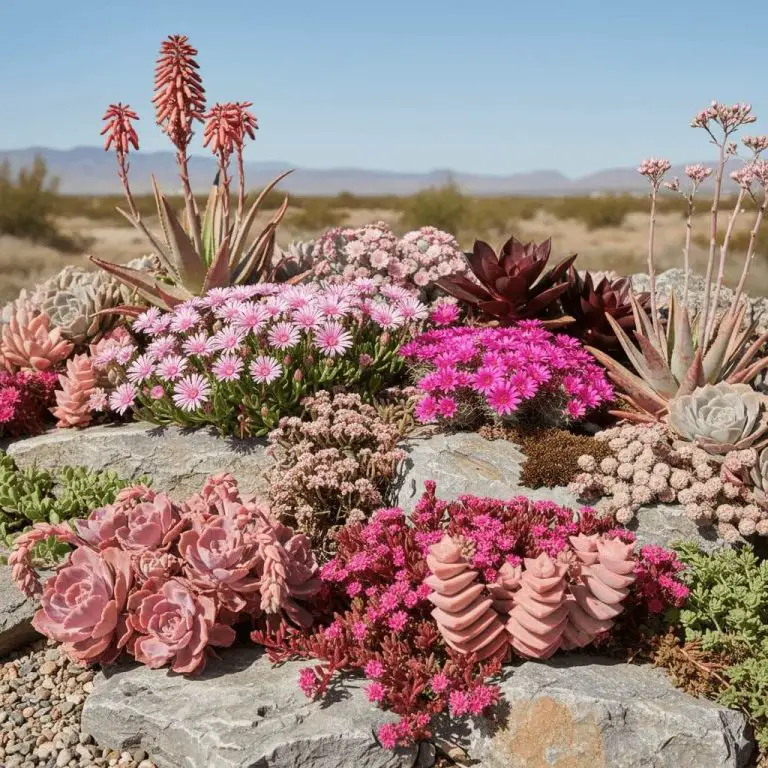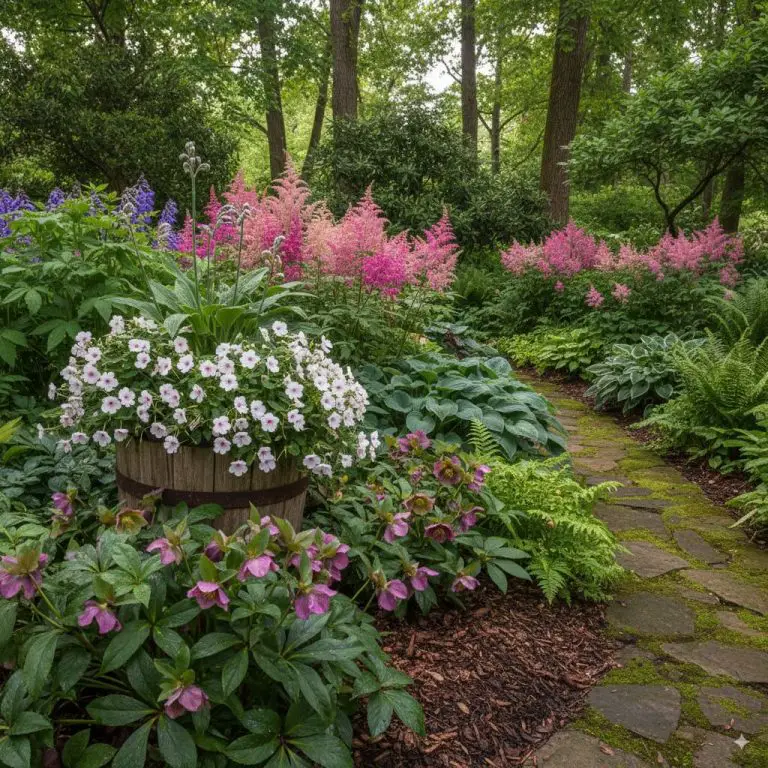Wild Flowering Plants: Create A Thriving, Low-Maintenance Oasis
Have you ever looked at a perfectly manicured lawn and thought, “There has to be a more vibrant, life-filled way to garden?” You’re not alone. Many of us dream of a garden that buzzes with life, bursts with color, and doesn’t demand every spare moment of our time.
I promise you, that dream is completely within reach. The secret lies in embracing the wilder side of gardening. By learning how to grow wild flowering plants, you can create a stunning, resilient, and eco-friendly sanctuary right outside your door.
In this complete guide, we’ll walk through everything you need to know. We’ll explore the incredible benefits of these natural beauties, discover the best plants to start with, follow a step-by-step planting process, and learn the simple secrets to keeping them happy. Let’s get started!
What's On the Page
- 1 Why Choose Wild Flowering Plants? The Surprising Benefits for Your Garden and Planet
- 2 Getting Started: A Curated List of Easy-to-Grow Wild Flowering Plants
- 3 How to Plant Wild Flowering Plants: Your Step-by-Step Success Guide
- 4 The Ultimate Wild Flowering Plants Care Guide: Less Work, More Beauty
- 5 Troubleshooting Common Problems with Wild Flowering Plants
- 6 Frequently Asked Questions About Wild Flowering Plants
- 7 Your Wild Garden Awaits
Why Choose Wild Flowering Plants? The Surprising Benefits for Your Garden and Planet
Switching even a small part of your garden to wild flowering plants isn’t just about aesthetics; it’s a powerful choice with ripple effects. These aren’t your fussy, high-maintenance divas. They are resilient, resourceful, and incredibly rewarding.
Here are just a few of the benefits of wild flowering plants that I’ve seen firsthand in my own garden.

🌿 The Companion Planting & Gardening Book (eBook)
Bigger harvests, fewer pests — natural pairings & simple layouts. $6.99
Get – $6.99
🪴 The Pest-Free Indoor Garden (eBook)
DIY sprays & soil tips for bug-free houseplants. $4.89
Get – $4.99They Create a Haven for Pollinators
One of the most joyful rewards is watching your garden come alive. Native bees, butterflies, hummingbirds, and other beneficial insects are essential for a healthy ecosystem, and wild flowering plants are their primary food source. Planting them is like rolling out a welcome mat for nature’s hardest workers.
They Are Incredibly Low-Maintenance
Because these plants are adapted to your local climate, they’ve learned to thrive without constant intervention. Once established, they typically require less water, less fertilizer, and less fuss than many traditional garden ornamentals. This means more time for you to simply enjoy your beautiful space.
They Promote a Healthy, Sustainable Garden
Embracing sustainable wild flowering plants is a cornerstone of eco-friendly gardening. Their deep root systems help improve soil structure, prevent erosion, and increase water absorption. Since they don’t need chemical fertilizers or pesticides to thrive, you’re also reducing harmful runoff into local waterways. It’s a win for your garden and a win for the planet.
Getting Started: A Curated List of Easy-to-Grow Wild Flowering Plants
The sheer number of options can feel overwhelming, but don’t worry—these flowers are perfect for beginners! The key is to choose plants native to your region. A quick search for “[Your State/Province] native plants” will give you the best results, but here are some widely adaptable and beloved choices to get you started.
For Sun-Drenched Spots
- Coneflower (Echinacea purpurea): A classic for a reason! These daisy-like purple flowers are tough, drought-tolerant, and a magnet for butterflies. They bloom for months, providing long-lasting color.
- Black-Eyed Susan (Rudbeckia hirta): With their cheerful golden-yellow petals and dark centers, these beauties bring a wave of sunshine to any garden. They are incredibly easy to grow from seed and will often self-sow for more flowers next year.
- Yarrow (Achillea millefolium): Yarrow boasts flat-topped clusters of tiny flowers in shades of white, yellow, or pink. It’s extremely drought-resistant and its fern-like foliage is beautiful even when not in bloom.
For Areas with Partial Shade
- Wild Columbine (Aquilegia canadensis): These delicate, bell-shaped flowers in red and yellow are a favorite of hummingbirds. They thrive in woodland settings and dappled sunlight, adding a touch of elegance.
- Jacob’s Ladder (Polemonium reptans): Known for its ladder-like leaf arrangement and clusters of beautiful, bell-shaped blue flowers, this plant is a lovely addition to a shady border.
- Foamflower (Tiarella cordifolia): This plant forms a lush groundcover with attractive leaves and sends up airy, white spikes of flowers in the spring. It’s perfect for brightening up shady corners.
How to Plant Wild Flowering Plants: Your Step-by-Step Success Guide
Alright, you’ve chosen your plants! Now for the fun part. This simple “how to wild flowering plants” process will set you up for success. The best time to plant is typically in the spring or fall, which gives the roots time to establish before the stress of summer heat or winter cold.
- Prepare Your Site: This is the most crucial step! Remove all existing grass, weeds, and other vegetation from the area you’ve chosen. You can do this by hand, or by “sheet mulching”—covering the area with cardboard and a thick layer of compost or mulch for several weeks to smother the competition.
- Loosen the Soil: You don’t need to till deeply, which can disturb the soil structure. Simply use a garden fork to loosen the top 6-8 inches of soil. This helps the new roots penetrate more easily. Avoid adding too much rich compost unless your soil is extremely poor; many wild flowering plants prefer lean soil.
- Arrange Your Plants: If you’re using nursery-grown plants, arrange them in their pots on top of the soil first. Play with the layout! Group plants in clusters of 3 or 5 for a more natural look, and place taller species toward the back.
- Dig and Plant: Dig a hole for each plant that’s about twice as wide as the pot but just as deep. Gently remove the plant from its container, loosen any circling roots with your fingers, and place it in the hole. The top of the root ball should be level with the surrounding soil.
- Backfill and Water Thoroughly: Fill the hole back in with the soil you removed, pressing gently to remove air pockets. Once everything is planted, give the entire area a deep, slow watering. This helps settle the soil and reduces transplant shock.
- Add Mulch: Apply a 2-3 inch layer of natural mulch, like shredded leaves or pine straw, around the plants. Be sure to keep the mulch from touching the plant stems directly. Mulch is your best friend—it conserves moisture, suppresses weeds, and regulates soil temperature.
The Ultimate Wild Flowering Plants Care Guide: Less Work, More Beauty
Welcome to the low-stress part of your gardening journey! The core of this wild flowering plants care guide is to observe and intervene only when necessary. These plants are survivors.
Watering Wisely
For the first year, you’ll need to water your new plants regularly (about once a week if it doesn’t rain) to help them establish strong root systems. After that? Most established native plants are remarkably drought-tolerant and will only need watering during prolonged, severe droughts. This is one of the top wild flowering plants best practices for water conservation.
Forget the Fertilizer
In most cases, you can skip the fertilizer. Wild flowering plants are adapted to native soils and often perform poorly in overly enriched conditions, which can lead to weak, floppy growth and fewer flowers. A thin layer of compost applied in the spring is all they’ll ever need, if anything.
Managing Weeds
Weeds will be your biggest challenge in the first couple of years. The mulch layer will help immensely, but be prepared to do some hand-weeding. As your wild flowers mature and fill in the space, they will naturally outcompete most weeds, creating a self-sustaining plant community.
End-of-Season Care
Resist the urge to “clean up” your garden in the fall! Leave the seed heads and stems standing through the winter. They provide crucial food for birds and shelter for beneficial insects. In early spring, just before new growth begins, you can then cut the old stems back to make way for the new season.
Troubleshooting Common Problems with Wild Flowering Plants
Even the toughest plants can run into issues. Don’t be discouraged! Here’s how to handle some common problems with wild flowering plants.
Problem: My Seeds Didn’t Sprout!
Solution: Many wildflower seeds require a period of cold, moist conditions to germinate—a process called stratification. If you’re sowing seeds directly, do it in the fall so they experience winter naturally. If starting indoors, you may need to refrigerate the seeds in a moist paper towel for several weeks before planting.
Problem: Plants are Floppy and Falling Over.
Solution: This is often a sign of too much of a good thing—either too much water or soil that is too rich. Cut back on watering and avoid adding any fertilizer. Some taller species, like Joe Pye Weed, may benefit from being planted near other sturdy plants they can lean on.
Problem: Weeds Are Taking Over!
Solution: Be persistent with hand-weeding in the first two years. Ensure you have a thick layer of mulch. Most importantly, plant densely! A tightly packed garden of desirable plants leaves little room for weeds to get a foothold. This is one of the best long-term wild flowering plants tips for weed control.
Frequently Asked Questions About Wild Flowering Plants
Can I just scatter a wildflower seed mix in my lawn?
While it sounds lovely, this method rarely works. Wildflower seeds need good seed-to-soil contact to germinate and can’t compete with an established lawn. You must remove the existing grass and weeds from the area first for the best chance of success.
How long will it take for my wildflower garden to look “full”?
Patience is a gardener’s best virtue! The first year, the plants sleep (focus on root growth). The second year, they creep (more foliage growth). By the third year, they leap! You’ll see significant growth and blooming in the second year, but the garden will really hit its stride and look lush and full by year three.
Are wild flowering plants messy?
They are definitely less formal than a traditional garden bed, which is part of their charm! If you prefer a tidier look, you can incorporate design elements like a mown border, a stone edge, or a simple path to give your wild garden a sense of intention and frame the natural beauty.
Your Wild Garden Awaits
There you have it—your complete wild flowering plants guide to creating a garden that is not only beautiful but also deeply connected to the world around it. You’re not just planting flowers; you’re building a habitat, supporting pollinators, and creating a resilient, low-effort landscape.
Start small. Choose one little corner of your yard to transform. Watch how it changes, who visits, and how it makes you feel. I guarantee you’ll fall in love with the untamed beauty you’ve cultivated.
Happy gardening!
- How To Cut Back Cucumber Plants For A Bigger, Healthier Harvest - November 7, 2025
- When To Cut Back Cucumber Plants – Your Ultimate Guide For A Bountiful - November 7, 2025
- Cucumber Plant Diseases Treatment – Your Guide To Spotting And - November 7, 2025


